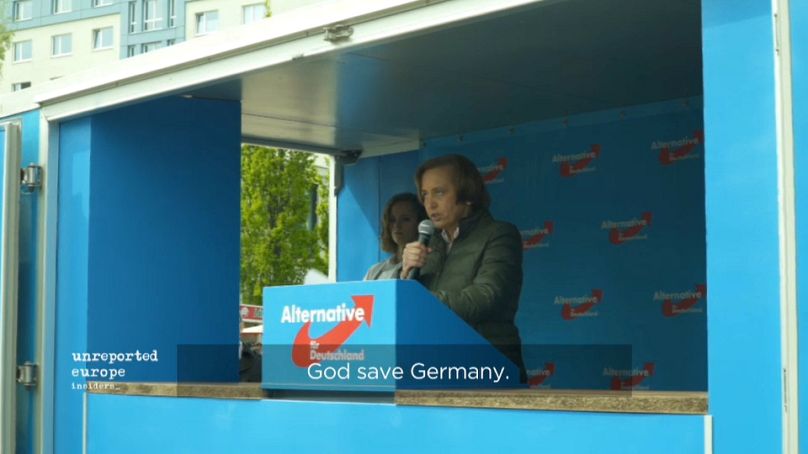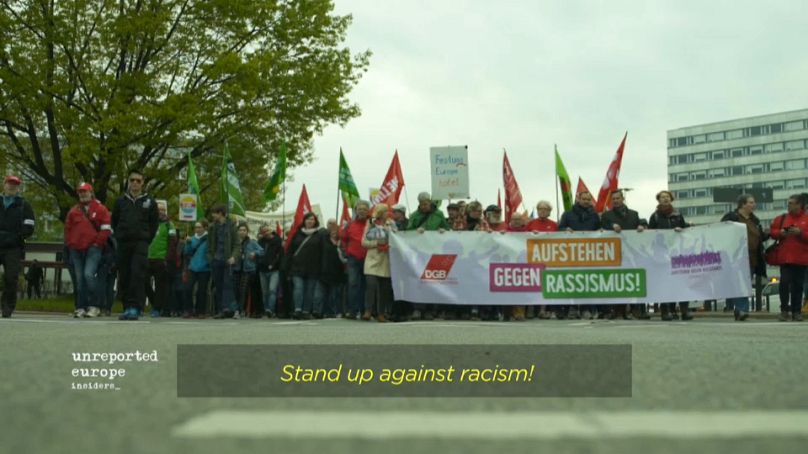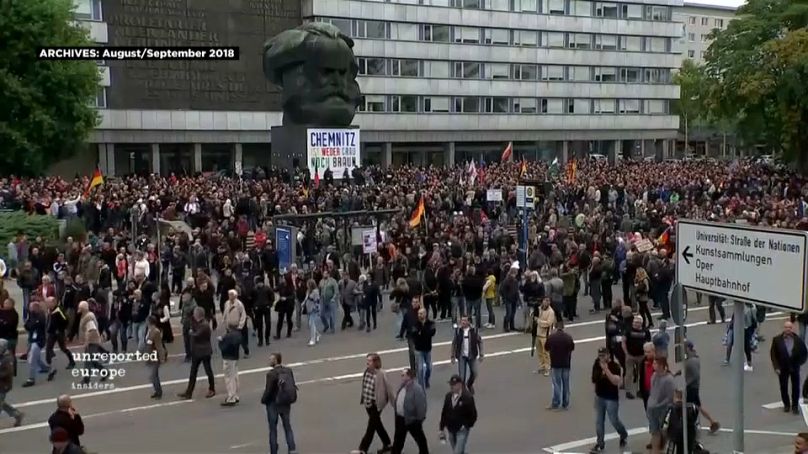Insiders looks at how the once-mighty industrial city that suffered during the transition from communism became known as a hub for far-right activity.
Once a model socialist town named Karl Marx City, Chemnitz in the east German state of Saxony has witnessed dramatic political changes over the years.
In this edition of Insiders: Unreported Europe Ayman Oghanna visits the city which once fought for the fall of a totalitarian communist regime but is now fast becoming the symbol of Germany’s newly assertive far right, once again exposing the country’s east-west divide.
It started in August 2018 when a German man was stabbed to death, allegedly during a brawl with two refugees from Iraq and Syria. What followed, was a week of angry anti-immigrant protests that saw neo-Nazis, far-right groups and thousands of ordinary citizens marching together in Chemnitz against migration.
The protests stand as a watershed moment amongst the outpouring of anti-immigrant hatred that has swelled as Germany’s far-right grows bolder and stronger, following the 2015 migrant crisis.
The rise of the Alternative for Germany party
At the heart of Germany’s newly assertive far right is the AfD, Alternative for Germany, a populist anti-immigrant party.
Whilst the AfD has only been around for six years, it has already achieved stunning success, becoming the third largest party in the Bundestag.
Now they are campaigning for the European elections.
In April the AfD presented its election programme in the city of Offenburg, calling for "a Europe of fatherlands," opposing the EU's immigration, financial and climate policies.
“Germany was a kind of a peaceful place outside of all troubles we had globally, then (in 2015) (Angela) Merkel decided to open the country and to let in almost one million, mostly Muslim, mostly male immigrants in one year, and that has changed the country,” says AfD candidate Maximilian Krah.
“We are the only political force that is in opposition towards mass migration, but we know from the polls that almost 50 percent of the population are against mass immigration, so obviously it was a boom.”
And a boom it was, as by September 2018 the AfD had become Chancellor Angela Merkel's biggest opposition party, although recent polls show its support has fallen to 12 percent - its lowest level since March last year.
Germany’s polarised politics
As the AfD rally in Chemnitz, another protest is going on just 100 meters away. Like most cities in Germany, Chemnitz is divided. Green, liberal and left-wing protestors demanding to be heard and to oppose the AfD's growth.
“I’m not really sure if they are on the rise,” says Green supporter, Robert Hay. “I think they have always been here. But now they are more confident and are coming out and claiming that they control the town and that is simply not true.”
East-West divide
Also that day, Pro Chemnitz, the right-wing citizens’ movement that organised last year’s anti-immigrant protests are celebrating the opening of their new offices, drawing a huge protest outside.
Pro Chemnitz leader, Martin Kohlmann, says whilst traditionally west Germany was not a place where you're proud to be German, this was never an issue in the east.
“It wasn't like this here in the former German Democratic Republic (eastern Germany from 1949 to 1990). It has its roots in the re-education after the war. Because in the west, there were taught by the Americans and the English that the German thinking, German kind of living and thinking, led to the crimes of National Socialism. And here (in the east), we had the Russians and they told us that Capitalism was the bad thing that leads to fascism. So we were not educated that being German is a big problem.”
So perhaps it's not a coincidence that while the AfD has supporters in the west, its the second strongest political force in the east where nationalism is less shunned upon, boasting well over 20% support. And last year it was Saxony’s top vote-getter.
As well as this there is still a hugely unequal distribution of wealth almost 30 years after the Berlin Wall came down and many in the east feel a sense of loss of the Heimat (homeland).
But it would be misleading to conclude that there’s a problem with refugees. Historically east Germany was also a far more homogeneous society than the west, but that hasn’t stopped nationalism and scaremongering about “alienation” taking root.
Since 2015, Germany has registered over 1.2 million asylum seekers. Chemnitz, however, has a relatively small foreign-born population, only 8 percent. Yet rates of hate crimes against immigrants are higher there than in the rest of the country.
Yet with the 2017 elections, a new political moment in Germany was born. Regardless of how much prosperity, jobs, and social benefits Angela Merkel's 12 years in office had brought, she didn't do well at the ballot box. The AfD, however, secured 12.6% of the vote, having campaigned on migration and border security, and
It took months for a government to be formed and this insecurity was a boost to the AfD. As a “grand coalition” took shape it took advantage by focusing on one topic, refugees, ignoring that numbers had fallen and a majority of immigrants and refugees live peacefully in Germany.
Hardening attitudes
Simmering anger over migration turned into real violence in Chemnitz.
The August 2018 killing of Daniel Hillig, a carpenter of Cuban descent, tapped into residents’ deepest anxieties about the city’s rising refugee population. That's despite Hillig's friends telling the German media he was adamantly opposed to any attempt to demonize foreigners for political gain.
André Löscher a social worker with an NGO that helps victims of racist violence says in the whole of Saxony they had 317 attacks, and nearly 80 of them were in Chemnitz:
“It’s an increase of about 40 percent from the year before in the whole of Saxony and in Chemnitz it’s about 400 percent.”
Last October, Masoud Hashemi a political refugee from Iran who has a Persian restaurant in the city was attacked by three men dressed in black.
“One man made this salute and said Heil Hitler, and started to smash stuff. He threw a samovar into my face, destroyed the kitchen and beat me.”
Masoud still doesn't understand why he was attacked.
“I work; I pay my insurances. I pay my rent. Why they come to me and beat up me? They come to me because I’m Persian, what I have done?”
It’s not just immigrants who are the victims of far-right hate crimes, last year outside Chemnitz, a 27-year-old man was tortured to death for being homosexual.
Anti-Semitism also appears to be on the increase. Uwe Dziuballa, is the owner of Schalom, a Kosher Restaurant that opened in 2000.
His restaurant has been the target of anti-Semitic attacks, with rocks, bottles and a metal pipe being thrown at the building.
So, whilst it’s true that hate crimes are rising, alongside casual racism and support for parties like the AfD, there’s a lot of resistance and anger towards the far right as well.
The question is, whether that will be enough to prevent the political center from shifting in the country that is seen as the defender of a liberal and tolerant Europe.
















